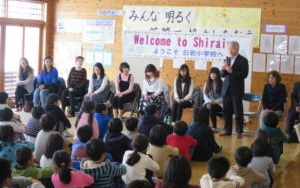Curriculum Contents
Curriculum Contents
Akita is emblematic of Japan’s rural areas: Dependent for a long time on agriculture as the core of its economy, Akita was one of the first prefectures to experience population decline, long before Japan as a country did. As such, it has been a case study for the effects of rural depopulation and rural rehabilitation efforts.
Students in this program study Akita’s unique circumstances, current issues, and cultural assets in the classroom, then interact directly with their subject matter through research visits and excursions.

Field Trips
This program features weekly field trips, allowing participants to explore various parts of Akita Prefecture each week. Destinations include central Akita City, Oga City, Yuzawa City, and Gojome Town. These visits provide the opportunity to engage with areas facing social challenges, and immerse in Japan’s and Akita’s traditional culture, lifestyle, and customs.
Through these field trips, participants will gain a deep understanding of Akita through direct interaction with various issues and cultural aspects, from contemporary challenges to traditional and modern culture. Additionally, participants will contemplate the problems of population decline and depopulation facing Akita, and consider potential solutions.


Interaction with Local People in Akita
The main feature of this program is community interaction. During the program, participants will visit the Shiraiwa district in Akita Prefecture’s Daisen City. There they will visit the local elementary school and interact with the children to learn about the education system and their lifestyle.
Participants will also help the Shiraiwa community set-up and hold its annual winter festival. Through the festival, they will interact with local residents and experience the strong sense of community and connection that characterizes the area. Participants will gain a deeper understanding of the region’s lifestyle, habits, customs, traditions, and community preservation.




Japanese Language Ability
The program makes heavy demands on students’Japanese language skills, particularly speaking and listening. Thus, this course is limited to students with advanced Japanese language proficiency. The program offers additional language instruction, such as courses and practice in the most polite keigo forms of speech. Throughout the course, students have the opportunity to develop their abilities in all four language skills – and learn to speak the local Akita dialect, as well!
Tel. +81-(0)18-886-5927, +81-(0)18-886-5937
Fax. +81-(0)18-886-5853
Email:international+specialprograms@gl.aiu.ac.jp
Office Hours (Mon – Fri) 9:00 – 12:00 and 13:00 – 17:00
